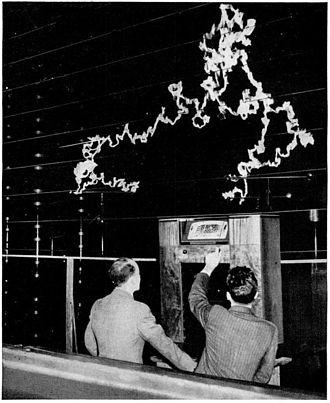Frequency modulation
However, under severe enough multipath conditions it performs much more poorly than AM, with distinct high frequency noise artifacts that are audible with lower volumes and less complex tones.[citation needed] With high enough volume and carrier deviation audio distortion starts to occur that otherwise wouldn't be present without multipath or with an AM signal.is the frequency deviation, which represents the maximum shift away from fc in one direction, assuming xm(t) is limited to the range ±1.It is important to realize that this process of integrating the instantaneous frequency to create an instantaneous phase is quite different from what the term "frequency modulation" naively implies, namely directly adding the modulating signal to the carrier frequency which would result in a modulated signal that has spurious local minima and maxima that do not correspond to those of the carrier.While wideband FM uses more bandwidth, it can improve the signal-to-noise ratio significantly; for example, doubling the value ofThe carrier and sideband amplitudes are illustrated for different modulation indices of FM signals.For particular values of the modulation index, the carrier amplitude becomes zero and all the signal power is in the sidebands.[5] Since the sidebands are on both sides of the carrier, their count is doubled, and then multiplied by the modulating frequency to find the bandwidth.Compared with an optimum AM scheme, FM typically has poorer SNR below a certain signal level called the noise threshold, but above a higher level – the full improvement or full quieting threshold – the SNR is much improved over AM.Additional techniques, such as pre-emphasis of higher audio frequencies with corresponding de-emphasis in the receiver, are generally used to improve overall SNR in FM circuits.A common method for recovering the information signal is through a Foster–Seeley discriminator or ratio detector.Slope detection demodulates an FM signal by using a tuned circuit which has its resonant frequency slightly offset from the carrier.As the frequency rises and falls the tuned circuit provides a changing amplitude of response, converting FM to AM.In Software-Defined Radio implementations the demodulation may be carried out by using the Hilbert transform (implemented as a filter) to recover the instantaneous phase, and thereafter differentiating this phase (using another filter) to recover the instantaneous frequency.Alternatively, a complex mixer followed by a bandpass filter may be used to translate the signal to baseband, and then proceeding as before.When an echolocating bat approaches a target, its outgoing sounds return as echoes, which are Doppler-shifted upward in frequency.This keeps the returning echo in the same frequency range of the normal echolocation call.This dynamic frequency modulation is called the Doppler Shift Compensation (DSC), and was discovered by Hans Schnitzler in 1968.FM is also used at intermediate frequencies by analog VCR systems (including VHS) to record the luminance (black and white) portions of the video signal.FM also keeps the tape at saturation level, acting as a form of noise reduction; a limiter can mask variations in playback output, and the FM capture effect removes print-through and pre-echo.A continuous pilot-tone, if added to the signal – as was done on V2000 and many Hi-band formats – can keep mechanical jitter under control and assist timebase correction.This technique, known as FM synthesis, was popularized by early digital synthesizers and became a standard feature in several generations of personal computer sound cards.Edwin Howard Armstrong (1890–1954) was an American electrical engineer who invented wideband frequency modulation (FM) radio.FM receivers employ a special detector for FM signals and exhibit a phenomenon known as the capture effect, in which the tuner "captures" the stronger of two stations on the same frequency while rejecting the other (compare this with a similar situation on an AM receiver, where both stations can be heard simultaneously).Frequency drift or a lack of selectivity may cause one station to be overtaken by another on an adjacent channel.Frequency drift was a problem in early (or inexpensive) receivers; inadequate selectivity may affect any tuner.FM is commonly used at VHF radio frequencies for high-fidelity broadcasts of music and speech.This gives FM another advantage over other modulation methods requiring linear amplifiers, such as AM and QAM.[15] Frequency modulated systems are a widespread and commercially available assistive technology that make speech more understandable by improving the signal-to-noise ratio in the user's ear.They are also called auditory trainers, a term which refers to any sound amplification system not classified as a hearing aid.




FM broadcastingNFM (disambiguation)PassbandmodulationSC-FDETC-PAMHierarchical modulationSpread spectrumDemodulationLine codingMultiplexingGeneral Electricelectric arcstaticinformationcarrier waveinstantaneous frequencytelecommunicationsradio broadcastingsignal processinganalogfrequency deviationDigital datafrequency-shift keyingmodemsfax modemscaller IDRadioteletypeFM radiobroadcastingtelemetrynewbornstwo-way radiosound synthesissignal-to-noise ratioradio frequency interferenceamplitude modulation (AM)multipathphase modulationangle modulationamplitude modulationamplitudebaseband signalsinusoidalFourier analysisfrequency spectrumcontinuous wavesinusoidharmonicsine waveBessel functionscarrier frequencychirp spread spectrumFamily Radio Servicewaterfall plotsidebandCarson bandwidth rulerule of thumbbandwidthvoltage-controlled oscillatorphase-modulated signalcrystal-controlled oscillatorfrequency multiplierFoster–Seeley discriminatorratio detectorphase-locked loopdetectionSoftware-Defined RadioHilbert transformecholocationDoppler shiftintermediate frequenciesluminancechrominancemagnetic tapemegahertzequalizersnoise reductionlimiterFM captureprint-throughpre-echotimebase correctionBesselaudio frequenciesFM synthesissynthesizerspersonal computersound cardsEdwin Howard ArmstrongInstitute of Radio Engineerssignal bandwidthinterferencehigh fidelityFM broadcast bandreceiversdetectorcapture effectFrequency driftselectivityadjacent channelstereoradio frequencieshigh-fidelitybroadcastsspeechamateur radioswitching amplifierconstant-amplitude signalsless battery powerlinear amplifierMikhail A. Bonch-BruevichNizhny Novgorod Radio Laboratoryassistive technologyhearing aidauditory processing disordersensorineural hearing losscochlear implantsContinuous-wave frequency-modulated radarFM stereoFM-UWBHistory of radioAmerican Speech–Language–Hearing AssociationEBSCOhostAnalog televisionbroadcasting topics